EnglishItaliano
Schifanoia. Mese per mese: Marzo-Ariete
Schifanoia. Month by month: March-Aries
Il cielo
The Sky
a cura di Marco Bertozzi
by Marco Bertozzi
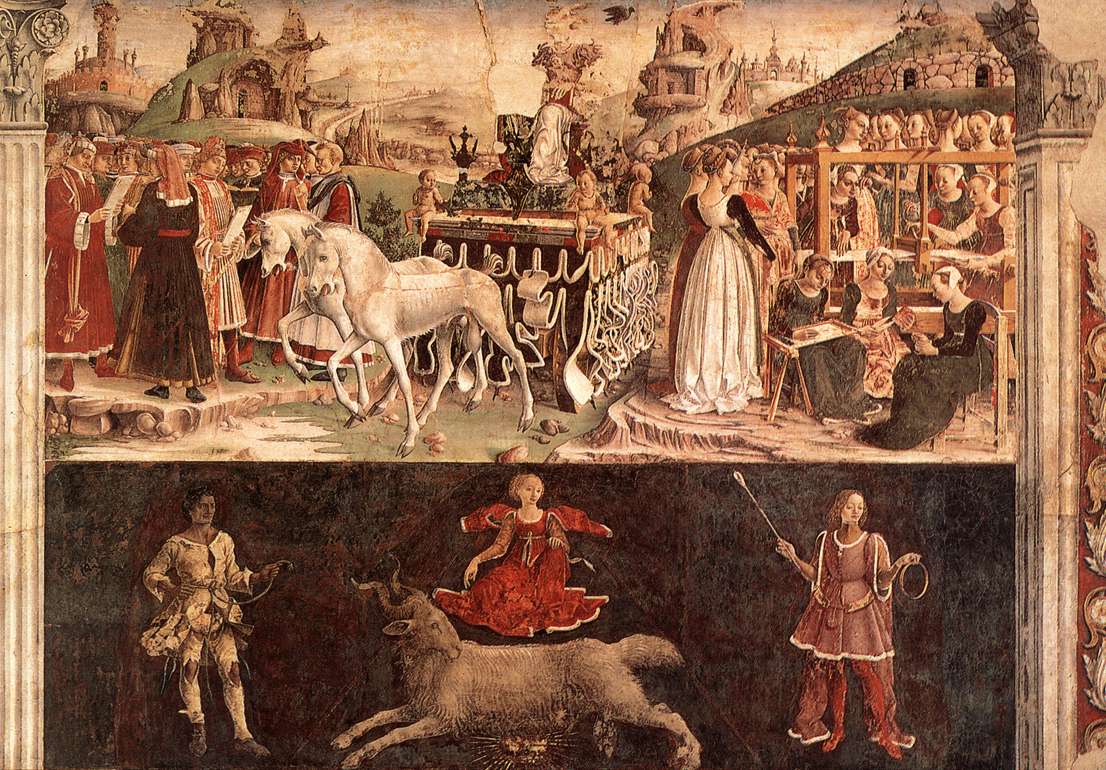
Francesco del Cossa e bottega, I due registri superiori del mese di Marzo
Francesco del Cossa and workshop, the two upper registers of the month of March
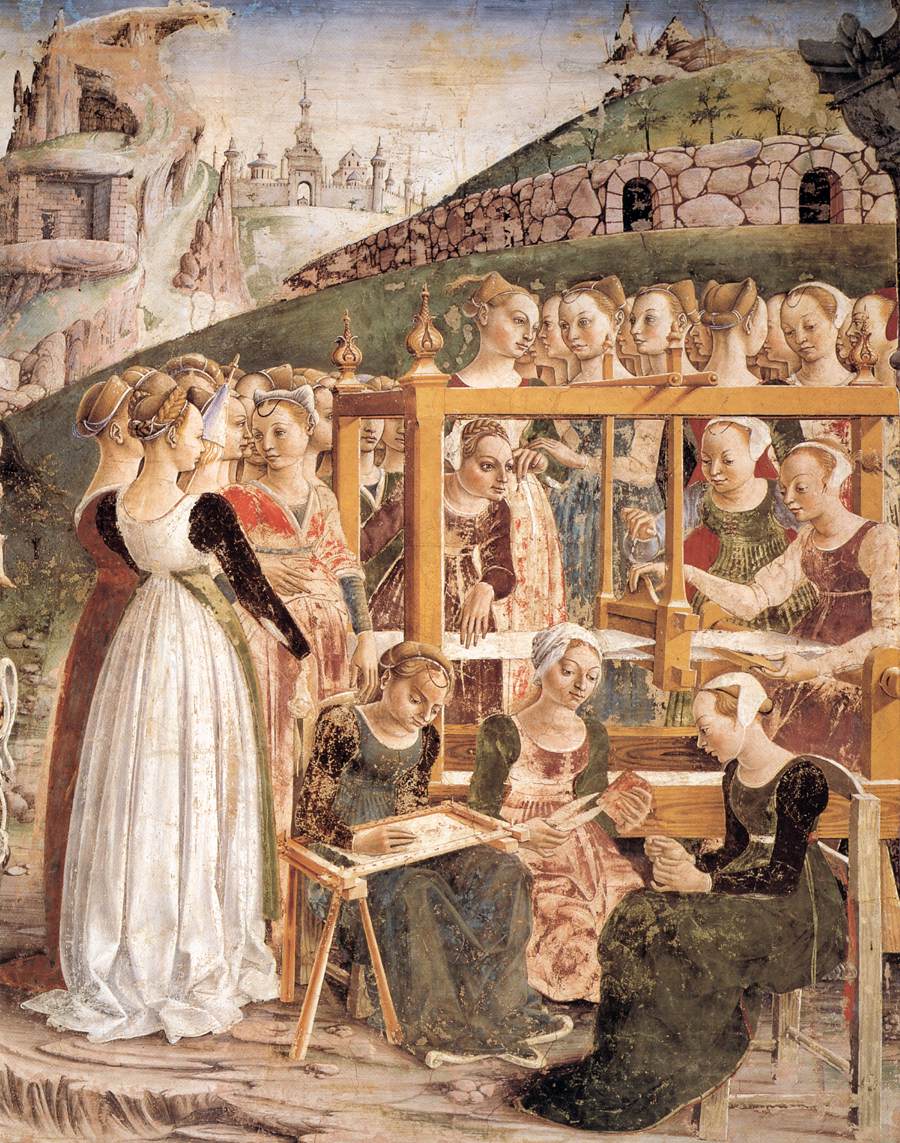
I figli dei pianeti: le tessitrici
Children of the planets: the weavers
Fascia superiore
Upper register
Tutela di Pallade Atena (Minerva), dea della sapienza, della guerra, delle scienze e delle arti. La divinità tutelare celebra il suo trionfo su un carro trainato da liocorni e ornato da velature, che ondeggiano al vento. L’astuta figlia di Zeus e Metis è qui rappresentata nelle vesti di dea della giustizia, cioè di saggia e prudente amministratrice della città, e (come Atena Ergane) di protettrice delle arti e delle attività femminili (la tessitura).
A sinistra, la rappresentazione di figli e discepoli della dea: medici, artisti, poeti, giuristi, appartenenti allo studio ferrarese. Tra questi personaggi, è riconoscibile Leon Battista Alberti (il cui “ritratto” è stato identificato da Ranieri Varese). A destra, tre tessitrici al telaio, attorniate da un gruppo di eleganti dame, mostrano quale sorte toccherà ai nati sotto il segno dell’Ariete.
Atena è collegata alla tessitura tramite il mito di Aracne. Le tre figure femminili, in primo piano, rappresentano le tre Moire (Parche), che scandiscono l’eterno svolgersi del destino.
Da notare che, nella fascia inferiore, è raffigurato Borso d’Este, mentre amministra saggiamente la giustizia. L’architrave interno del palazzo, in cui si trova Borso, reca l’inequivocabile scritta “IUSTICIA”. I benefici influssi di Atena si riflettono, dunque, nella maggiore virtù del magnifico principe di Ferrara: la complessa tessitura dei dipinti è destinata a esaltarne il giusto governo, oltre che la prevista e attesa nomina papale a duca della città estense.
The sky of March is under the guardianship of Pallas Athena (Minerva), goddess of wisdom, war, sciences and the arts. The guardian goddess is celebrating her triumph on a chariot drawn by unicorns and decorated with banners that flutter in the breeze. The shrewd daughter of Zeus and Metis is shown here as patron of justice; she is the wise, prudent ruler of the city, and (as Athena Ergane), protectress of the arts and female activities.
On the left side are "the children" and disciples of the goddess: doctors, artists, poets and lawyers all sons of the high intellectual Ferrarese society. Among them is Leon Battista Alberti (his portrait was recognised by Ranieri Varese). On the right, three weavers at their looms surrounded by a group of elegant ladies demonstrate the destiny of those born under the sign of Aries.
Athena is connected to weaving through the myth of Arachne. The three female figures in the forefront represent the three Moirai (Fates), who mark the eternal unfolding of fate.
It should be noted that in the lower register, Borso d’Este is portrayed whilst wisely administering justice. The internal architrave of the palace in which Borso is situated bears the unequivocal inscription “IUSTICIA”. The beneficial influence of Athena is reflected, therefore, in the superior virtues of the magnificent prince of Ferrara. The complex weaving of the painting will pay tribute to his just government, and his expected and awaited nomination by the pope to Duke of Ferrara.
Fascia mediana - I tre decani, accompagnati dal segno zodiacale dell'ariete
Middle register – the three decans accompanied by the zodiac sign of Aries

I tre decani con il segno zodiacale dell'Ariete
The three decans accompanied by the zodiac sign of Aries
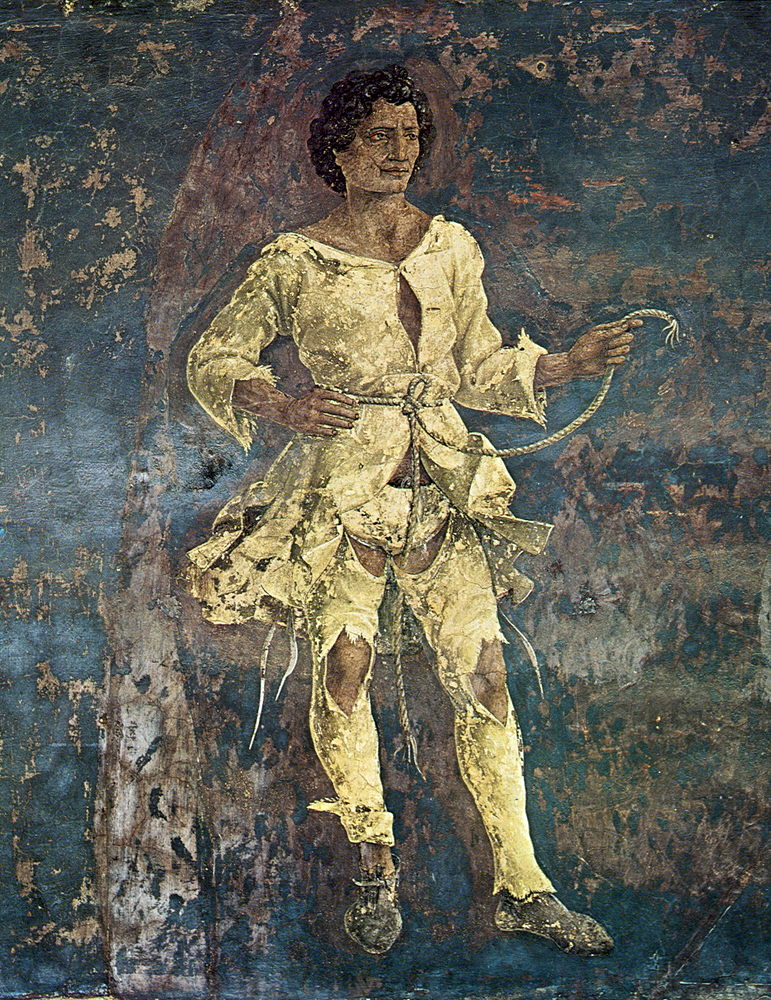
Primo decano dell'Ariete
The first decan of Aries
Primo decano (Ariete I)
First decan (Aries I)
Il primo decano dell’Ariete è un uomo di pelle scura, occhi rossi, robusto, con giacca e pantaloni bianchi, stracciati. Sta in piedi, in atteggiamento minaccioso, è cinto in vita da una corda, di cui tiene un capo con la mano sinistra.
La rappresentazione deriva dalla sfera indiana del trattato di Albumasar. Warburg volle, con tenacia, scorgervi la metamorfosi dell’antica costellazione greca di Perseo, qui disarmato, i cui attributi non sono più riconoscibili, se non nell’atteggiamento aggressivo del decano (Warburg [1912] 1966). Più probabilmente, la figura risale ad una costellazione fantasma, che si trova in zona di confine, tra Pesci e Ariete. Manilio (Astr. V, 645-655), che scrive il suo poema astrologico nel primo secolo d.C., attribuisce una curiosa sorte ai nati sotto tale configurazione astrale, quella cioè di arrampicarsi in funamboliche evoluzioni su una fune tesa verso il cielo. La fune di questo fantomatico acrobata si riferisce al lungo nastro che collega i due Pesci della costellazione omonima (Bertozzi 1999, 38-45; Bertozzi 2007).
The first decan of Aries is a robust, dark-skinned man, with red eyes wearing torn white jacket and trousers. He is standing in a threatening attitude, and has around his waist a chord one end of which he is holding in his left hand.
The image derives from the Indian sphere in Albumasar’s treatise. Warburg was tenaciously determined to see in this figure the metamorphosis of the ancient Greek constellation of Perseus, here disarmed, and whose attributes are no longer recognisable, if not by his aggressive stance (Warburg [1912] 1966). More probably, the figure is associated with a constellation in the borderline area between Pisces and Aries. Manilius (Astr. V, 645-655), writing his astrological poem in the first century DC, assigns a curious fate to those born under this configuration of the stars, which is to climb acrobatically upwards on a taut cable reaching towards the sky. The cable of this phantom acrobat refers to the long ribbon that connects the two fish of Pisces (Bertozzi 1999, 38-45; Bertozzi 2007).
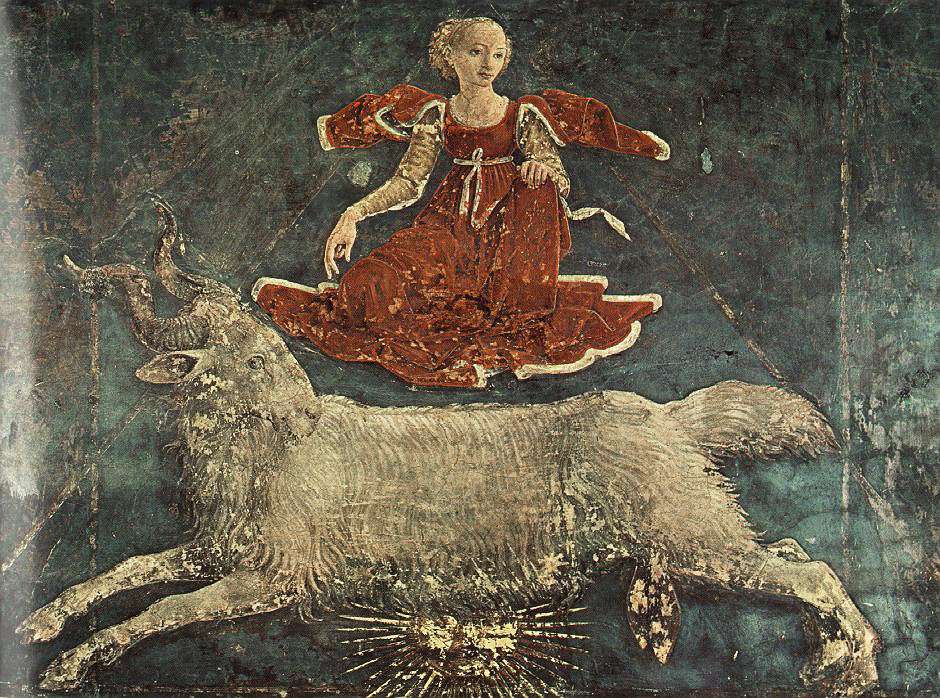
Secondo decano dell'Ariete
The second decan of Aries
Secondo decano (Ariete II)
The second decan of Aries (Aries II)
Una donna dai capelli biondi, accovacciata; indossa un elegante vestito rosso, con panni svolazzanti sulle spalle.
La figura riproduce, solo in parte, la descrizione della sfera indiana di Albumasar: “una donna che indossa vestiti di colore rosso, ha un solo piede e la sua immagine è simile a quella di un cavallo” (Bertozzi 1999, 46; Jaffé [1932] 1999, 115). L’aspetto regale e l’abbigliamento sfarzoso alludono alla sovranità di Cassiopea, collegata (secondo il mito astrale) alle costellazioni di Cefeo, Perseo, Andromeda e Cetus (il mostro marino).
A crouching woman with fair hair wears an elegant red dress with a fluttering garment on her shoulders.
The figure replicates, only in part, the description in Albumasar’s Indian sphere of a woman wearing red garments. She, has only one foot, and her image is like that of a horse (Bertozzi 1999, 46; Jaffé [1932] 1999, 115). Her regal aspect and her sumptuous clothing hint at the Greek queen Cassiopeia, connected (according to astral myth) to the constellations of Cepheus, Perseus, Andromache and Cetus (the sea monster).
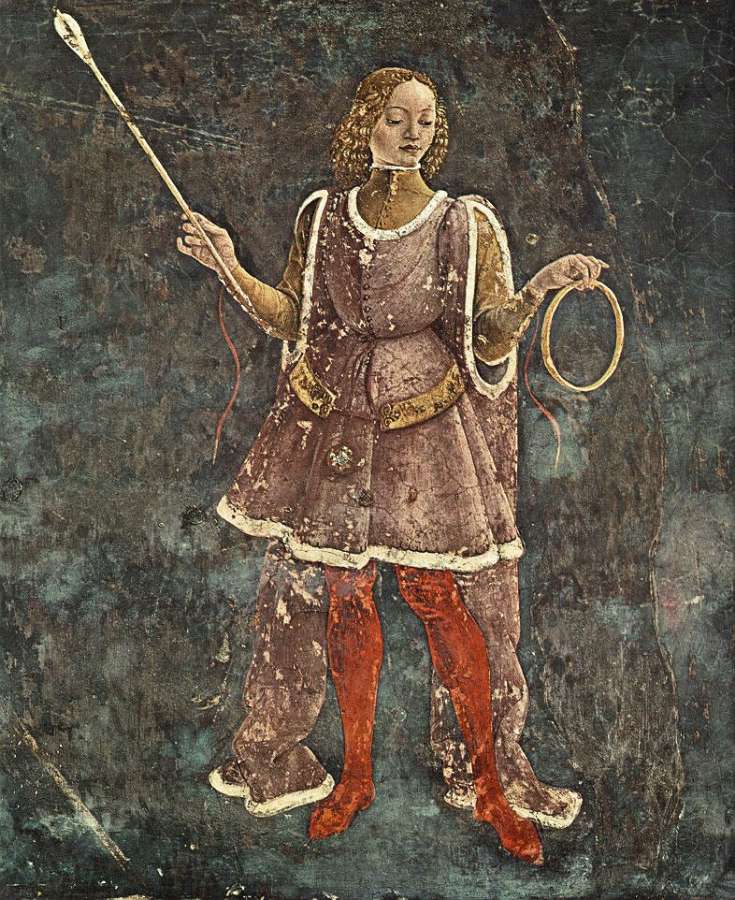
Terzo decano dell'Ariete
Third decan of Aries
Terzo decano (Ariete III)
Third decan of Aries (Aries III)
Un giovane, di bell’aspetto, dai capelli biondi, lunghi e arricciati, elegantemente vestito. Tiene una freccia nella mano destra e un cerchio con la sinistra; da entrambi i polsi scendono lunghi lacci.
La descrizione si ritrova nella sfera indiana di Albumasar (Bertozzi, 1999, 46-47; Jaffé [1932] 1999, 115). Gli attributi - cioè la freccia (corrispondente alla frusta), il cerchio e i lacci pendenti dai polsi - alludono ad Enioco, la costellazione dell’Auriga menzionata da Manilio (Astr. V, 67 ss.): la costellazione di Enioco (l’Auriga), che si leva al quindicesimo grado dell’Ariete, trasmetterà (ai nati sotto la sua influenza) quelle straordinarie qualità di cocchiere che lo resero degno, agli occhi di Giove, di essere assunto in cielo.
A handsome young man with long, curly fair hair and elegantly dressed. In his right hand he holds an arrow, and in his right a hoop; long laces hang from both his wrists.
This description is found in Albumasar’s Indian sphere (Bertozzi, 1999, 46-47; Jaffé [1932] 1999, 115). His attributes – the arrow (corresponding to a whip), the hoop and the laces hanging from his wrists - hint at the Auriga constellation mentioned by Manilius (Astr. V, 67 ss.): The constellation of Eniocus (The Charioteer), that rises up to the fifteenth degree of Aries, will bestow upon those born under its influence the extraordinary powers of the Charioteer that made him worthy in the eyes of Jove to be taken up into the sky.
Gli artisti di marzo*
a cura di Giovanni Sassu
Il mese di Marzo apre la decorazione della parete orientale del Salone, eseguita ad affresco come quella settentrionale.
La differenza di stile tra l’ala est e quella nord balzava agli occhi di Camillo Laderchi già nel 1840; per la prima, inoltre, lo studioso registrava una forte relazione con la cultura toscana e fiorentina. Sulla scorta dell’interpretazione di un passo di Vasari, egli arrivava così a spendere il nome di Lorenzo Costa, la cui biografia fu da dall’aretino erroneamente fusa con quella di Cossa.
Il nome di quest’ultimo fu invece avanzato per la prima volta nel 1871 da Crowe e Cavalcaselle, seppur restringendo il suo intervento alle sole porzioni superiori e mediane dei mesi della parete orientale. Poco dopo, fu Fritz Harck (1884) ad allargare la presenza cossesca a tutta la superficie della parete est, non mancando di indicare però anche la partecipazione di collaboratori.
Nel 1885 la pubblicazione da parte di Giuseppe Campori e di Adolfo Venturi della lettera scritta nel marzo del 1470 da Francesco del Cossa e indirizzata a Borso d’Este, rivelò la correttezza delle osservazioni di Harck: nella missiva, infatti, l’artista ferrarese dichiarava di essere autore di «quilli tri campi verso l’anticamera», ovvero proprio del fronte orientale.
Questa scoperta ha indirizzato la critica successiva in modo definitivo, deviando l’attenzione su altri aspetti. Nella fascia cortigiana del mese di Marzo, ad esempio, Adolfo Venturi (1931) ha colto nella figura del cavaliere che tiene a bada il cavallo imbizzarrito una citazione in controparte del San Giorgio delle ante d’organo del Duomo, dipinte da Cosmè Tura entro il giugno del 1469.
Da segnalare, infine, la proposta di Roberto Longhi (1940 e 1956) di riconoscere nella comitiva posta a sinistra sotto l’arco il documentato intervento di Baldassarre d’Este (chiamato a Schifanoia da Borso nel 1471 a uniformare i suoi ritratti in tutti i mesi del ciclo). Tale suggerimento è stato accantonato a causa dello spostamento di anagrafe di una delle pezze d’appoggio longhiane (il Ritratto d’uomo del Museo Correr, ora visto come opera di Antonio da Crevalcore), ma soprattutto perché l’intervento di Baldassarre, essendo verosimilmente realizzato a secco, dovette essere asportato con le operazioni di scialbatura e descialbatura.
Un’ulteriore annotazione tecnica appare importante per la scansione dei lavori. Le sovrapposizioni degli intonaci e le tracce di buche pontaie consente di stabilire che i lavori sono progrediti da sinistra verso destra e dall’alto verso il basso, quindi da Maggio verso Marzo. Il mese in oggetto è stato quindi dipinto da Cossa per ultimo. Ciò documenta che la porzione con la citazione turiana deve essere stata eseguita a lavori quasi terminati. Ne consegue che la totale assenza di echi del capolavoro del Museo della Cattedrale nelle altre aree lascia ipotizzare che il resto della parete sia stata realizzata prima del giugno del 1469, quando il dipinto di Cosmè risulta terminato e quindi visibile. .
(*Estratto da Cosmè Tura e Francesco del Cossa. L’arte al tempo di Borso d’Este, cat. della mostra a cura di M. Natale, Ferrara 2007, 434-435).
The artists of march
edited by Giovanni Sassu
The month of March opens the decoration of the eastern wall of the Hall, and is executed in fresco as is the northern wall.
The difference in style between the northern and eastern wings struck Camillo Laderchi immediately in 1840; in the case of the former, the scholar recorded a strong relationship with the culture of Tuscany and Florence. On the basis of his interpretation of a passage in Vasari, he went so far as to link it with the name of Lorenzo Costa, whose biography by Vasari was mistakenly merged with that of Cossa.
The name of the latter, however, was advanced for the first time in 1871 by Crowe and Cavalcaselle, although restricting his intervention only to the middle and upper portions of the months of the eastern wall. Shortly after, it was Fritz Harck (1884) who extended the presence of Cossa to the entire surface of the eastern wall, not failing to indicate, however, the participation of assistants.
In 1885 the publication by Giuseppe Campori and Adolfo Venturi of the letter written in March 1470 by Francesco del Cossa and addressed to Borso d'Este, proved the accuracy of Harck’s observations: in the letter, in fact, Costa declared he was the author of “Those three fields towards the reception area", which is precisely the eastern wall.
This discovery permanently defined later criticism, diverting attention to other aspects. In the courtesan section in the Month of March, for example, Adolfo Venturi (1931) took the figure of the knight holding the runaway horse at bay to be a counterpoint quotation of the San Giorgio of the organ doors of the Cathedral, painted by Cosmè Tura before the end of June 1469.
Of note, finally, is the suggestion of Roberto Longhi (1940 and 1956) to recognize in the party to the left under the arch the documented intervention by Baldassare d'Este (called to Schifanoia by Borso in 1471 to standardize his portraits in all the months of the cycle).
This suggestion was shelved because of the change in date of one of Longhi’s supporting documents (the Portrait of a Man of the Correr Museum, now seen as the work of Antonio da Crevalcore), but mainly because the intervention of Baldassarre, being probably applied dry, was removed by plastering and whitewashing.
Another technical note is key to analysing the works. The overlapping of the plaster and the traces of scaffolding holes makes it possible to determine that the work proceeded from left to right and from top to bottom, therefore from May to March.
The month in question was therefore painted by Cossa last. This substantiates the notion that the portion with the Tura citation must have been performed when the work was almost finished. It follows that the total absence of echoes of the masterpiece in the Cathedral Museum in other areas allows us to assume that the rest of the wall was executed before June 1469, when Cosmè’s painting was finished and was therefore visible.
*(Estract from Cosmè Tura e Francesco del Cossa. L’arte al tempo di Borso d’Este, cat. of the exhibition curated by M. Natale, Ferrara 2007, 434-435).
> Riferimenti bibliografici
English abstract
Month by month: March-Aries is a guide to reading the frescoes of the zodiac sign of Aries in Palazzo Schifanoia and it also reports the artists who painted these works.
keywords | Palazzo Schifanoia; Salone dei Mesi; Frescoes; Zodiac; Aries.
English abstract
Month by month: March-Aries is a guide to reading the frescoes of the zodiac sign of Aries in Palazzo Schifanoia and it also reports the artists who painted these works.
keywords | Palazzo Schifanoia; Salone dei Mesi; Frescoes; Zodiac; Aries.
Per citare questo articolo / To cite this article: M. Bertozzi, SChifanoia. Mese per mese: Marzo-Ariete, “La Rivista di Engramma” n. 105, aprile 2013, pp. 44-47 | PDF
Per citare questo articolo in versione inglese/ To cite this article english version: E. Thomson, Schifanoia. Month by month: March-Aries, “La Rivista di Engramma” n. 105, aprile 2013, pp. 48-50 | PDF